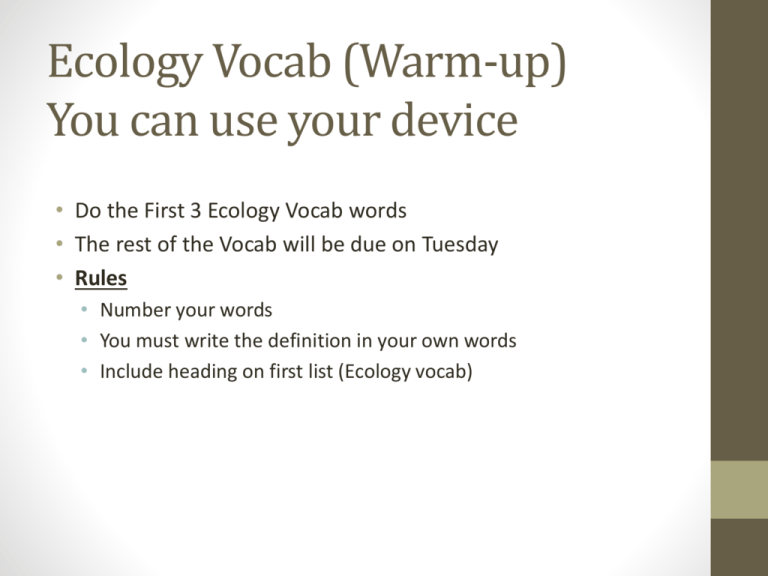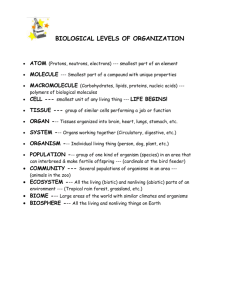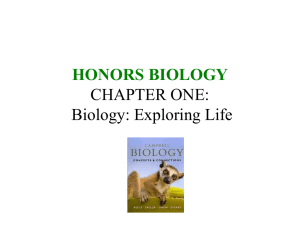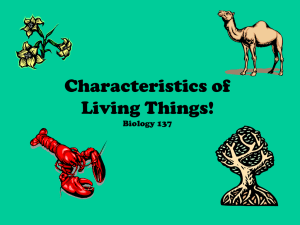ppt
advertisement

Ecology Vocab (Warm-up) You can use your device • Do the First 3 Ecology Vocab words • The rest of the Vocab will be due on Tuesday • Rules • Number your words • You must write the definition in your own words • Include heading on first list (Ecology vocab) The Characteristics of Life http://www.le.ac.uk/bl/background2.jp What is Biology? • Biology is the study of life! Bio-: Life -ology: the study of How does Biology relate to your daily life?? Biology & Society • Studying Biology allows a person to become educated enough to make decisions on issues that impact society and themselves. • Can you name an example of where you might hear about Biology in your everyday life? • What might be something you hear about? Living or Not? • There are many familiar things in this world that we classify as “living” and “nonliving”. • How do you know if something is alive or was living at one point? • BY THE EIGHT CHARACTERISTICS OF LIFE!! The Eight Characteristics of Life • Organization & the presence of one or more cells • Response to a stimulus (stimuli) • Homeostasis • Metabolism • Growth & Development • Reproduction • Change through time • Universal Genetic Code Organization and Cells NUMBER ONE • Organization: The high degree of order within an organism’s internal and external parts and in it’s interactions with the living world. Example: vs. Continuing with Cells… • All cells have some degree of organization. • Cell: smallest unit that can perform all of life’s processes. Two cell types: • Unicellular (ex. Bacteria) • Multicellular (ex. Tree, human) Organ Systems • The highest level of organization • Organ systems are made up of organs. • Organs: structures that carry out specialized jobs within and organ system. Organs are made of tissues. What are tissues?? • They are groups of cells with similar abilities that allow an organ to function. • So…TISSUES ARE MADE OF CELLS! • Example: Nervous tissue in an ear allows an ear to detect sound. What’s Inside a Cell? • Organelles! – Tiny structures carrying out functions necessary for the cell to remain alive. Organelles are made up of… BIOLOGICAL MOLECULES! Molecules are chemical compounds that provide physical structure & allow energy use, movement, & other cellular functions. What makes up a molecule? • Biological molecules are made up of… ATOMS!! • Atoms: simplest particle of an element that retains all the properties of a certain element. Response to Stimuli NUMBER TWO • Stimulus: A physical or chemical change in the internal or external environment. Can you think of some examples of different stimuli?? Why would you want to be able to respond and react to changes in your environment? TO STAY ALIVE!! Homeostasis NUMBER THREE • This means you are maintaining stable internal conditions via different mechanisms. • Internal conditions stay the same even though environmental conditions are changing constantly! What are some examples of regulatory systems? Examples: Temperature & water content Metabolism NUMBER FOUR • The sum of all the chemical reactions that take in & transform energy & materials from the environment. • Two processes to gain energy: • Photosynthesis (plants, algae, & some bacteria) • Consumption (animals eating prey/food) • Living organisms use energy to power ALL the life processes… • Movement, growth, repair, etc. Growth & Development NUMBER FIVE • ALL LIVING THINGS GROW & INCREASE IN SIZE!! • They grow by the division & enlargement of cells. • Some nonliving things grow as well… Can you think of an example? Cell Division • The formation of two new cells from an existing cell. • Multicellular Organisms: cell divisions, cell enlargement & development • Unicellular Organisms: cell division then cell enlargement What is Development? • The process by which an organism becomes a mature adult. • An adult organism is composed of many cells specialized for different functions. Examples: Hearing, seeing, carrying oxygen in the blood. THE HUMAN BODY IS COMPOSED OF TRILLIONS OF SPECIALIZED CELLS, ALL OF WHICH ORGINATED FROM A SINGLE CELL… THE FERTILIZED EGG!! Reproduction NUMBER SIX • Reproduction: the process where an organism produces new organisms like themselves. • NOT ESSENTIAL TO AN INDIVIDUAL ORGANISMS SURVIVAL… Why is it necessary then for the survival of a species? Pass Me the Info! • Sexual Reproduction: Two organisms of the same species! The offspring are similar to the parents but not identical! • Asexual Reproduction: One organism Genetically identical organisms Change Through Time NUMBER SEVEN • Populations of living organisms evolve or change through time! • Being able to change is important for survival in an ever changing world! • This is why we have such diversity amongst all living things here on Earth! Universal Genetic Code NUMBER EIGHT • Hereditary information is transferred to offspring via DNA (deoxyribonucleic acid) • Gene: short segment of DNA that contains the instructions for a single trait of an organism. • How do living things transfer hereditary information?? Atom-Molecule-Organelle-Cell-Tissue-Organ-Organ System-Organism Population-Community-Ecosystem-Biosphere Biome 1.Tropical rain forest 2.Tropical dry forest 3. Tropical savanna 4.Temperate Grassland 5. Desert 6. Temperate Woodland and scrubland 7. Temperate forest 8. Northwestern coniferous forest 9. Boreal forest (taiga) 10. Tundra 11. Mountains and ice caps Item 1. Lichen 2. water 3. soil 4. algae 5. air in balloon 6. wax candle 7. seeds 8. rock 9. fruit 10. plant LIFE CHARACTERISTICS Cell Organization Reproduction Growth and Development Responds to the Environment Obtains & Uses Energy Living NonLiving Name __________________________________________Period ____________ Date ___________ Notes: All living things have the following characteristics. Write a note or example below each characteristic. 1. Cell Organization 5. Obtains & Uses Energy 2. Reproduction 6. Universal Genetic Code 3. Growth and Development 7. Homeostasis 4. Responds to the Environment 8. Evolve






